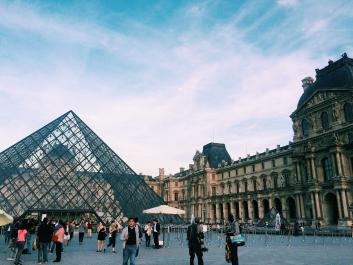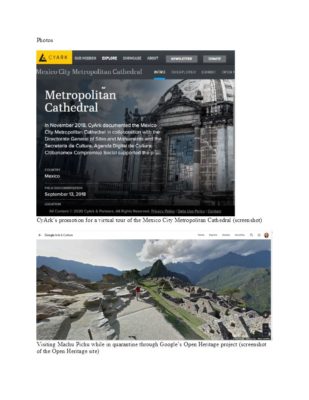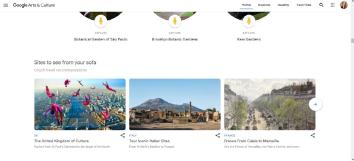Artificial reality is the likely future of preservation
11 June 2020 – Megan Crutcher
NCPH 2020 awards, digital media, preservation, methods, digital history, historic preservation, 2020 annual meeting

How can we get the closest to replicating the emotional and physical feeling of standing in the Louvre courtyard at sunset? Photo credit: Megan Crutcher
Editor’s Note: Editor’s note: This is the first in a series of reflective posts written by winners of awards intended to be given out at the NCPH 2020 annual meeting in Atlanta, Georgia. Megan Crutcher of Duquesne University received a graduate student travel award.
The American Historical Association defines preservation as “the identification, evaluation, physical preservation, and interpretation of historically and culturally significant sites.” In many ways, the most important part of this definition is the interpretation, as it is the interpretation of context that gives structures their meanings. Over the past decade, and especially the past several months during the COVID-19 pandemic, the growth of virtual means of communication, digitization, and other uses of technology have increasingly virtualized preservation. Never before have we been forced to so drastically re-conceptualize how people interact with the world, and specifically with historic preservation, in completely virtual ways. Creating appropriate and meaningful virtual methods for people to interact with historic places is paramount for the future of preservation.
Virtual reality (VR) and other artificial and augmented realities seem to be preservation’s future direction. Most robotics professionals posit that artificial reality is poised to take over much of our daily lives. How can a VR environment be embedded with the purpose of place that traditional historic environments allow visitors to explore through free-choice learning? Access to historical evidence and historic sites, while increasingly open, has normally been molded and mediated by experts and experienced through free-choice learning by visitors. Free-choice learning and exploration allow people to experience their own powerful sense of place. This individual power of place is often difficult to replicate in VR.
The tech industry has largely failed to analyze the downsides of artificial reality applied to history, while the preservation field has often failed to accept artificial reality as a legitimate future direction. There are real challenges to the digital world. One only need examine big tech privacy conflicts, data security issues, technical difficulties, and the effects of complete virtualization on social behavior in our current COVID-19 world to see the potential pitfalls of applications of machine learning in historic preservation. Do people really want to live in a world of artificial realities? Most museum-based visitor studies show that people value “the real thing.” Danny Bonenberger argued that often VR “emphasizes hyperrealism at the expense of rigor, documentation of sources, and uncertainty.” VR reads like a video game, a fiction, rather than a tool to increase understanding. It is a historical misconception that artificial reality can “freeze time.” Artificial reality allows us to freeze a moment like a photograph, but it does not replace that time’s reality. Even the most sophisticated systems do not completely replace all the sensations and experiences of physical reality. Indeed, should this even be the preservationist’s goal—to freeze time—or is our goal to enhance and promote the contextual power of place? This cuts to the core of what history is and why it is studied, shared, and preserved.

Screenshots of popular tour platforms CyArk and Google’s Open Heritage site. Screenshots: Megan Crutcher
Tech giants tend to see digital copies of the world as certainties; VR Scout claimed that preserving sites in VR “ensures they’ll truly survive the test of time,” and heritage tech company CyArk argued that digitization of historic sites preserves the power of place that people so often feel at physically preserved sites. Researchers at the University of Sheffield argued that VR can revolutionize and transform the cultural model toward inclusion, accessibility, education, and democratization of heritage. Is VR truly the “ultimate immersive experience”? Maybe this is true of the most sophisticated immersive reality systems, but we are not yet at a point where these systems are applied to heritage and historic preservation. Most previous cultural applications of VR have used it in the context of cultural heritage to provide visual stimulus, an experience that is image or object based. But these VR applications only provide image or environment-based experiences without an internal explanation, raising even more questions about accessibility.
With all of these obstacles or downsides, why move toward VR? The National Park Service defines preservation as a “conversation with our past about our future” and a way to “transmit our understanding of the past to future generations.” VR can help bond people with the past in a way that draws them into a conversation to promote preservation for the future. Part of the task of preservation in VR is to replicate this power of place that people so often feel at physically preserved sites. Most effective uses of artificial reality in historic preservation are able to “blend physical and virtual environments, and connect its users with real and artificial agents.” This means a system that effectively transitions between the real and artificial worlds and embeds a social dynamic in the platform. It also means that users and visitors to virtual preservation sites have to be able to rely on natural movement and navigation as they would in the real world. In a more sophisticated system, visitors might be able to move around the site simply by walking, open doors using real motions, and interact with the site in physically natural ways. This is what the designers of the Etruscanning project, a VR interaction with a preserved Etruscan tomb, call “perceptive-sensorimotor dynamics.” The future of preservation must include initiatives like this.

Google offers a slew of tours, sites, ecological wonders, and more through Open Heritage. Screenshot: Megan Crutcher
ArchaeoVirtual is one big step forward for the field in emphasizing artificial reality as a future movement. The archaeological tourism bureau of Italy began organizing ArchaeoVirtual in 2006, a specific section of their work dedicated to these issues. They see tech as a tool to facilitate storytelling, emotional engagement, and to allow visitors to experience preserved sites in meaningful ways. In another successful move, Google has partnered with a machine learning and heritage company, CyArk, to pioneer technology that allows historic sites to be imaged and digitized in semi-immersive 3D. The Google OpenHeritage project is accessible for free online, and allows audiences to visit hundreds of sites, museums, and monuments around the world. It is seriously impressive, but that should be no surprise, given the amount of resources Google is probably able to devote to this project. Methodologically, OpenHeritage relies on new applications of traditional methods and allows the audience to interact with places and other people through virtual reality.
Operating on the assumption that artificial intelligence and artificial reality are likely going to become modus operandi for most people within the next few years, the best route forward is for preservation to embrace and mold these technologies for specific purposes. This requires a proactive stance and large systematic changes to the preservation field. VR and machine learning research has rarely relied on traditional historical models to create new technologies. Interdisciplinary collaboration is imperative. It is also imperative that we avoid the Luddite narrative of technology as evil, the alarmist narrative of historic places and historic preservation as obsolete (and the ensuing panic over automation of preservation jobs), or the rootless narrative of historic places as unimportant. Technology like artificial reality is a tool that we must learn to use, and not only to use but to become leaders in. This will require massive change in the way we educate, practice, and innovate in preservation. The lack of resources at most cultural institutions and nonprofits who carry out preservation work almost ensures that—as it stands—they will never compete with big tech companies on the VR front. This needs to change. It’s time to strike a balance between tech and public history, and for preservation perhaps this means moving toward artificial reality and VR as primary conveyances of public interpretation.
Acknowledgements: Many thanks to NCPH, Adina Langer, Nicole Belolan, the NCPH board; Dr. Stephanie Gray, Duquesne University; Paul Schydlo, Carnegie Mellon University Robotics Institute; Rob Pfaffmann, Pfaffmann + Associates, for showing me preservation in action; and the “Commemoration and Preservation” course at Duquesne University history department for many fruitful discussions about what preservation is and why we do it.
~Megan Crutcher received an M.A. in public history from Duquesne University, and begins a Ph.D. in nautical archaeology at Texas A&M University in Fall 2020, where she will study conservation and interpretation of underwater sites. She can be found at www.megancrutcher.com and tweeting @crutcher_megan.



